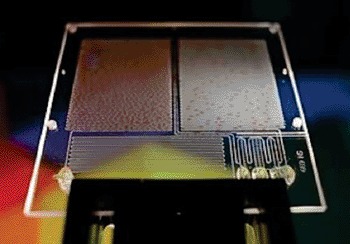Different Bacteria Cultures Maintained in Microfluidic System
|
By LabMedica International staff writers Posted on 13 Aug 2013 |

Image: Microfluidic system for multiple bacterial cultures (Photo courtesy of Polish Institute of Physical Chemistry).
A fabricated microfluidic device allows hundreds of different bacteria cultures to be maintained simultaneously.
The system allows for the merging, transporting and splitting of microdroplets where strictly controlled chemical reactions and the cultivation of bacterial colonies can be performed.
A group of scientists at the Institute of Physical Chemistry (Warsaw, Poland) engineered the microfluidic systems from polymer plates that correspond to the size of a credit card. Inside the system, a carrier fluid, mostly oil, carries microdroplets containing chemicals, flows laminarly through tiny channels of diameters in the range of tenths or hundredths of a millimeter. In this single microfluidic system thousands of different chemical reactions can be carried out during a day.
The microsystem is composed of two branches of microchannels forming densely arranged zigzags. A few hundred droplets can circulate in the microchannels, at a distance of about one centimeter from each other. The microdroplets move in a pendular movement from one branch to the other. Each droplet circulating within the microfluidic system has its own unique identifier, assigned by the optoelectronic system. It allows the scientist to monitor at any time what operations have been carried out on each microdroplet. A single droplet can include over 100,000 bacteria that are unable to move between the droplets, as the bacteria cannot cross the surface membrane of a microdroplet, and the carrier liquid used to transport microdroplets is not an environment favorable for the life of bacteria.
Piotr Garstecki, PhD, DSc, the lead author, said, “We can transform each microdroplet into a real bioreactor. Therefore, in a single small plate we can have up to several hundreds of bioreactors, with different, controlled concentration of an antibiotic, a different antibiotic or even different bacterial species in each bioreactor.” The paper was published on July 15, 2013, in the journal Angewandte Chemie International Edition.
Related Links:
Polish Institute of Physical Chemistry
The system allows for the merging, transporting and splitting of microdroplets where strictly controlled chemical reactions and the cultivation of bacterial colonies can be performed.
A group of scientists at the Institute of Physical Chemistry (Warsaw, Poland) engineered the microfluidic systems from polymer plates that correspond to the size of a credit card. Inside the system, a carrier fluid, mostly oil, carries microdroplets containing chemicals, flows laminarly through tiny channels of diameters in the range of tenths or hundredths of a millimeter. In this single microfluidic system thousands of different chemical reactions can be carried out during a day.
The microsystem is composed of two branches of microchannels forming densely arranged zigzags. A few hundred droplets can circulate in the microchannels, at a distance of about one centimeter from each other. The microdroplets move in a pendular movement from one branch to the other. Each droplet circulating within the microfluidic system has its own unique identifier, assigned by the optoelectronic system. It allows the scientist to monitor at any time what operations have been carried out on each microdroplet. A single droplet can include over 100,000 bacteria that are unable to move between the droplets, as the bacteria cannot cross the surface membrane of a microdroplet, and the carrier liquid used to transport microdroplets is not an environment favorable for the life of bacteria.
Piotr Garstecki, PhD, DSc, the lead author, said, “We can transform each microdroplet into a real bioreactor. Therefore, in a single small plate we can have up to several hundreds of bioreactors, with different, controlled concentration of an antibiotic, a different antibiotic or even different bacterial species in each bioreactor.” The paper was published on July 15, 2013, in the journal Angewandte Chemie International Edition.
Related Links:
Polish Institute of Physical Chemistry
Latest Technology News
- Disposable Microchip Technology Could Selectively Detect HIV in Whole Blood Samples
- Pain-On-A-Chip Microfluidic Device Determines Types of Chronic Pain from Blood Samples
- Innovative, Label-Free Ratiometric Fluorosensor Enables More Sensitive Viral RNA Detection
- Smartphones Could Diagnose Diseases Using Infrared Scans
- Novel Sensor Technology to Enable Early Diagnoses of Metabolic and Cardiovascular Disorders
- 3D Printing Breakthrough Enables Large Scale Development of Tiny Microfluidic Devices
- POC Paper-Based Sensor Platform to Transform Cardiac Diagnostics
- Study Explores Impact of POC Testing on Future of Diagnostics
- Low-Cost, Fast Response Sensor Enables Early and Accurate Detection of Lung Cancer
- Nanotechnology For Cervical Cancer Diagnosis Could Replace Invasive Pap Smears
- Lab-On-Chip Platform to Expedite Cancer Diagnoses
- Biosensing Platform Simultaneously Detects Vitamin C and SARS-CoV-2
- New Lens Method Analyzes Tears for Early Disease Detection
- FET-Based Sensors Pave Way for Portable Diagnostic Devices Capable of Detecting Multiple Diseases
- Paper-Based Biosensor System to Detect Glucose Using Sweat Could Revolutionize Diabetes Management
- First AI-Powered Blood Test Identifies Patients in Earliest Stage of Breast Cancer
Channels
Clinical Chemistry
view channel
‘Brilliantly Luminous’ Nanoscale Chemical Tool to Improve Disease Detection
Thousands of commercially available glowing molecules known as fluorophores are commonly used in medical imaging, disease detection, biomarker tagging, and chemical analysis. They are also integral in... Read more
Low-Cost Portable Screening Test to Transform Kidney Disease Detection
Millions of individuals suffer from kidney disease, which often remains undiagnosed until it has reached a critical stage. This silent epidemic not only diminishes the quality of life for those affected... Read more
New Method Uses Pulsed Infrared Light to Find Cancer's 'Fingerprints' In Blood Plasma
Cancer diagnoses have traditionally relied on invasive or time-consuming procedures like tissue biopsies. Now, new research published in ACS Central Science introduces a method that utilizes pulsed infrared... Read moreMolecular Diagnostics
view channel
New Blood Test Detects 12 Common Cancers Before Symptoms Appear
Bowel cancer is the fourth most common cancer in the UK, with over 42,000 new diagnoses each year. Detecting bowel cancer in its early stages can be challenging, and as the disease progresses, survival... Read more
Blood Test Could Predict Relapse of Autoimmune Blood Vessel Disease
Neutrophils, once believed to be uniform in nature, have been discovered to exhibit significant diversity. These immune cells, which play a crucial role in fighting infections, are also implicated in autoimmune... Read moreHematology
view channel
New Scoring System Predicts Risk of Developing Cancer from Common Blood Disorder
Clonal cytopenia of undetermined significance (CCUS) is a blood disorder commonly found in older adults, characterized by mutations in blood cells and a low blood count, but without any obvious cause or... Read more
Non-Invasive Prenatal Test for Fetal RhD Status Demonstrates 100% Accuracy
In the United States, approximately 15% of pregnant individuals are RhD-negative. However, in about 40% of these cases, the fetus is also RhD-negative, making the administration of RhoGAM unnecessary.... Read moreImmunology
view channel
Stem Cell Test Predicts Treatment Outcome for Patients with Platinum-Resistant Ovarian Cancer
Epithelial ovarian cancer frequently responds to chemotherapy initially, but eventually, the tumor develops resistance to the therapy, leading to regrowth. This resistance is partially due to the activation... Read more
Machine Learning-Enabled Blood Test Predicts Immunotherapy Response in Lymphoma Patients
Chimeric antigen receptor (CAR) T-cell therapy has emerged as one of the most promising recent developments in the treatment of blood cancers. However, over half of non-Hodgkin lymphoma (NHL) patients... Read moreMicrobiology
view channel
Handheld Device Delivers Low-Cost TB Results in Less Than One Hour
Tuberculosis (TB) remains the deadliest infectious disease globally, affecting an estimated 10 million people annually. In 2021, about 4.2 million TB cases went undiagnosed or unreported, mainly due to... Read more
New AI-Based Method Improves Diagnosis of Drug-Resistant Infections
Drug-resistant infections, particularly those caused by deadly bacteria like tuberculosis and staphylococcus, are rapidly emerging as a global health emergency. These infections are more difficult to treat,... Read more
Breakthrough Diagnostic Technology Identifies Bacterial Infections with Almost 100% Accuracy within Three Hours
Rapid and precise identification of pathogenic microbes in patient samples is essential for the effective treatment of acute infectious diseases, such as sepsis. The fluorescence in situ hybridization... Read morePathology
view channel
Sensitive and Specific DUB Enzyme Assay Kits Require Minimal Setup Without Substrate Preparation
Ubiquitination and deubiquitination are two important physiological processes in the ubiquitin-proteasome system, responsible for protein degradation in cells. Deubiquitinating (DUB) enzymes contain around... Read more
World’s First AI Model for Thyroid Cancer Diagnosis Achieves Over 90% Accuracy
Thyroid cancer is one of the most common cancers worldwide, and its precise management typically relies on two primary systems: (1) the 8th edition of the American Joint Committee on Cancer (AJCC) or ... Read more
Breakthrough Diagnostic Approach to Significantly Improve TB Detection
Tuberculosis (TB) remains the deadliest infectious disease globally, with 10.8 million new cases and 1.25 million deaths reported in 2023. Early detection through effective screening is crucial in identifying... Read more
Rapid, Ultra-Sensitive, PCR-Free Detection Method Makes Genetic Analysis More Accessible
Genetic testing has been an important method for detecting infectious diseases, diagnosing early-stage cancer, ensuring food safety, and analyzing environmental DNA. For a long time, polymerase chain reaction... Read moreIndustry
view channel
Cepheid and Oxford Nanopore Technologies Partner on Advancing Automated Sequencing-Based Solutions
Cepheid (Sunnyvale, CA, USA), a leading molecular diagnostics company, and Oxford Nanopore Technologies (Oxford, UK), the company behind a new generation of sequencing-based molecular analysis technologies,... Read more
Grifols and Tecan’s IBL Collaborate on Advanced Biomarker Panels
Grifols (Barcelona, Spain), one of the world’s leading producers of plasma-derived medicines and innovative diagnostic solutions, is expanding its offer in clinical diagnostics through a strategic partnership... Read more




















